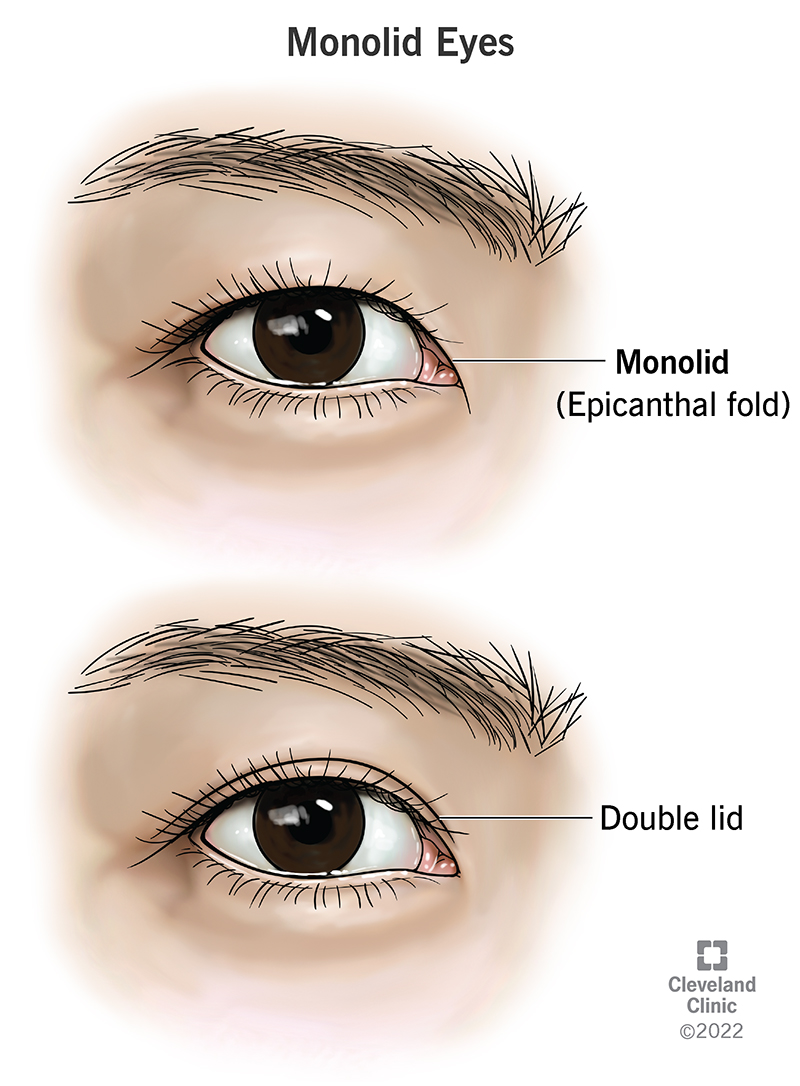Monolid eyes, or epicanthal folds, are an eyelid shape commonly seen in people of Asian descent. It’s also seen in people with genetic conditions. With monolid eyes, the skin of your upper eyelids covers the inner parts of your eyes. You don’t have folds dividing your eyelids into two parts. Monolid eyes are typically a harmless trait.
Advertisement
Cleveland Clinic is a non-profit academic medical center. Advertising on our site helps support our mission. We do not endorse non-Cleveland Clinic products or services. Policy

Monolid eyes are also called epicanthal folds or epicanthic folds. An epicanthal fold describes an eyelid shape. If you have epicanthal folds, the skin of your upper eyelid is smooth from the inner corner of your eye to the part of your eyebrow nearest to your nose. It covers the innermost edge of your eyes.
Advertisement
Cleveland Clinic is a non-profit academic medical center. Advertising on our site helps support our mission. We do not endorse non-Cleveland Clinic products or services. Policy
Monolids can make your eyes look smaller because you don’t have creases or folds separating your eyelids into two sections. Monolids decrease the opening between your upper eyelids and lower eyelids.
Epicanthal folds are very common, especially in people of Asian descent. Monolids are also a common characteristic found in some genetic conditions, such as Down syndrome.
If you have double lids (double eyelids), you have arc-shaped creases between your eyelashes and eyebrows. Monolids don’t have these visible creases between the eyelashes and eyebrows.
Monolids aren’t the same thing as ptosis. Ptosis is an abnormality that causes drooping of your eyelid. It can impair your vision and is often cosmetically unappealing because it generally affects only one eye. Ptosis may need to be surgically corrected.
Monolids are generally caused by genetics. They are found in about 50% of people of Asian descent. Epicanthal folds are also seen in non-Asian babies and young children before the bridge of their noses develops.
People born with fetal alcohol syndrome may also have epicanthal folds. Fetal alcohol syndrome can occur when a mother drinks during pregnancy. It can cause physical, behavioral and learning disabilities.
Advertisement
Epicanthal folds are also a facial characteristic commonly seen in many genetic conditions. These genetic conditions include:
Epicanthal folds are normal, harmless and don’t require treatment. But if you want to change the appearance of your eyelids, there are a few options:
Surgery isn’t necessary, or generally recommended, but plastic surgery can change the appearance of your eyelids:
Advertisement
If your baby is of Asian descent, epicanthal folds are a normal, common trait. If your baby isn’t Asian, their healthcare provider will see the trait before or during their first well-baby checkup.
If you notice epicanthal folds after your baby’s first well-baby checkup, call their healthcare provider. They will examine your baby for signs of Down syndrome and other genetic conditions. They may ask you about your family’s medical history, especially genetic conditions, intellectual disabilities or birth defects.
Monolids or epicanthal folds are common and normal, especially among people of Asian descent. Your monolids are a part of who you are and you may choose to embrace that. If you want to change the look of your eyelids, make sure you’re doing it for the right reasons. If your newborn isn’t Asian and they are born with epicanthal folds, be sure to speak with their healthcare provider. It may be normal, but they will evaluate your baby for genetic conditions that may need to be addressed.
Advertisement
Cleveland Clinic’s primary care providers offer lifelong medical care. From sinus infections and high blood pressure to preventive screening, we’re here for you.

Last reviewed on 02/22/2022.
Learn more about the Health Library and our editorial process.